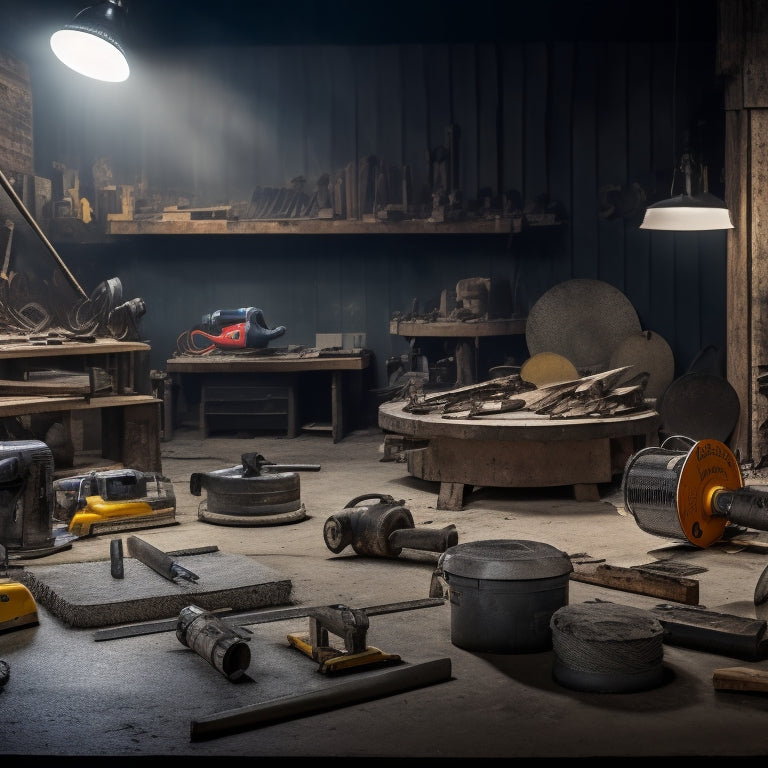
Top Tools for Cutting Concrete Slabs Efficiently
Share
You'll need a combination of specialized tools to efficiently cut concrete slabs, each designed to tackle specific tasks and materials with precision and power. Electric concrete saws offer precision for straight, curved, or angled cuts, while high-torque rotary hammers are ideal for breaking up and demolishing concrete efficiently. Diamond blade circular saws provide clean, accurate cuts, and concrete cutting reciprocating saws are perfect for rough cuts and demo work in confined spaces. For tough applications, gas-powered concrete cutters deliver high-torque power and exceptional cutting speed. Now that you have an overview of the top tools, you can explore the unique features and benefits that make each one essential for your project.
Key Takeaways
• Electric concrete saws offer precision for straight, curved, or angled cuts in concrete slabs with diamond or abrasive blades.
• High-torque rotary hammers efficiently break up and demolish concrete with lower vibration and adjustable torque control.
• Diamond blade circular saws provide clean, accurate cuts in concrete and asphalt with smooth, chip-free finishes.
• Concrete cutting reciprocating saws make precise cuts in confined spaces with aggressive cutting action and gentle to moderate pressure.
• Gas-powered concrete cutters deliver high-torque power and exceptional cutting speed for tough applications with ease of use and regular maintenance.
Electric Concrete Saws for Precision
When you need to make precise cuts in concrete, electric concrete saws prove to be a reliable and efficient choice, offering a high degree of accuracy and control.
These saws are designed to make straight, curved, or angled cuts in concrete slabs, making them ideal for various construction and renovation projects.
To get the most out of your electric concrete saw, it's important to select the right blade for the job. Diamond blades, for instance, are perfect for cutting through hard, abrasive concrete, while abrasive blades are better suited for softer materials.
Proper saw maintenance is also vital to guarantee peak performance and extend the lifespan of your tool. Regularly check and clean the saw's air vents, brushes, and blade shaft to prevent dust buildup and wear.
Additionally, make sure to follow the manufacturer's guidelines for blade selection, installation, and maintenance to avoid damaging the saw or compromising its performance.
High-Torque Rotary Hammers
As you shift to tasks that require breaking up or demolishing concrete, high-torque rotary hammers become the tool of choice, offering unparalleled power and efficiency for heavy-duty applications.
These powerful tools are designed to tackle the toughest concrete demolition jobs, providing you with the reliability and performance you need to get the job done quickly and effectively. High-torque rotary hammers excel in high torque applications, delivering the force and speed required to break through thick concrete slabs and foundations.
One of the key rotary hammer benefits is their ability to reduce fatigue and increase productivity. With a high-torque rotary hammer, you'll experience less vibration and reduced strain on your arms and back, allowing you to work for longer periods without exhaustion.
Additionally, these tools are often equipped with advanced features such as adjustable torque control and hammer-only mode, giving you greater control and precision over your work.
Diamond Blade Circular Saws
You'll achieve precise, controlled cuts in concrete and asphalt with diamond blade circular saws, which are designed to make clean, accurate cuts in a variety of materials. These saws are ideal for cutting through hard, abrasive surfaces, and their diamond-coated blades guarantee a smooth, chip-free finish.
When selecting a diamond blade, consider the type of material you'll be cutting, as well as the saw's power and speed. For instance, a blade with a high diamond concentration is best suited for cutting through thick, hard concrete, while a blade with a lower concentration is better for softer materials like asphalt.
Proper diamond blade maintenance is also essential for peak performance and extended blade life. Regularly clean the blade to prevent debris buildup, and store it in a dry place to prevent rust.
Additionally, choose a blade material that suits your specific cutting needs. For example, a steel-core blade is more durable and resistant to bending, while a segmented blade is better suited for cutting curved lines.
Concrete Cutting Reciprocating Saws
Concrete cutting reciprocating saws, with their push-and-pull motion, provide aggressive cutting action and increased versatility for making rough cuts, demo work, and cutting in tight spaces.
When you're working with concrete, you need a saw that can handle the toughest jobs, and reciprocating saws deliver. With their ability to make precise cuts in confined areas, they're ideal for cutting pipes, conduit, and other obstructions.
To get the most out of your reciprocating saw, you'll want to master the following cutting techniques:
-
Keep your saw blade straight: This will help prevent binding and reduce the risk of kickback.
-
Apply gentle to moderate pressure: Too much pressure can cause the blade to bind or break.
-
Use a slow, steady motion: This will help you maintain control and make smoother cuts.
Gas-Powered Concrete Cutters
What makes gas-powered concrete cutters a popular choice among professionals is their ability to deliver high-torque power and exceptional cutting speed, even in the toughest concrete applications. When you're working with these powerful tools, you'll appreciate the increased productivity and reduced fatigue that comes with their ease of use.
However, it's vital to take necessary safety precautions to avoid accidents. Always wear protective gear, including gloves, safety glasses, and a dust mask, and make certain the cutter is properly grounded to prevent electrical shocks.
Regular maintenance is also essential to extend the lifespan of your gas-powered concrete cutter. You should regularly check and replace the air filter, spark plug, and fuel filter to prevent engine issues. Additionally, lubricate the cutter's blades and bearings to reduce wear and tear.
Frequently Asked Questions
How Do I Prevent Overheating When Cutting Concrete Slabs?
When cutting concrete slabs, you'll want to prevent overheating to avoid damaging the blade or slab. To do this, you'll need to employ effective cooling techniques.
Start by using a blade with a high heat tolerance, designed specifically for concrete cutting. Next, apply a consistent, gentle flow of water to the blade while cutting, ensuring it's cooled adequately.
Additionally, take regular breaks to allow the blade to cool, and consider using a blade with built-in cooling features, such as air vents or a cooling system.
Can I Use a Concrete Saw to Cut Through Rebar?
When you're planning to cut through rebar, it's crucial to know that a concrete saw can be used, but with caution.
Rebar cutting requires a saw designed for concrete reinforcement, as it's specifically engineered to handle the added strength of steel reinforcement.
You'll need a saw with a diamond-coated blade and adequate power to effectively cut through the rebar without damaging the surrounding concrete or the saw itself.
What Safety Gear Is Necessary for Concrete Cutting?
'When it rains, it pours,' and concrete cutting can be a hazardous storm.
You're about to embark on a high-risk task, so gear up! Protect yourself from flying debris with impact-resistant eye protection, and don't forget hearing conservation - those saws can be ear-shattering.
Wear a dust mask, gloves, and steel-toed boots to prevent respiratory issues, skin abrasions, and crushed toes.
Don't take shortcuts; prioritize your safety above all else.
How Do I Minimize Dust When Cutting Concrete?
When cutting concrete, you'll want to minimize dust to avoid respiratory issues and improve visibility.
To achieve effective dust control, you'll need to adopt wet cutting methods. This involves using a saw or grinder equipped with a water supply system, which helps to suppress dust particles.
Additionally, consider using a vacuum system or dust extractor to capture any remaining particles, ensuring a cleaner and safer working environment.
Can I Rent Concrete Cutting Tools Instead of Buying?
As you weigh the costs of concrete cutting, think of your wallet as a delicate vase - fragile and easily shattered.
Renting concrete cutting tools can be a safety net, protecting you from the high upfront costs of buying. You'll reap cost benefits by only paying for the tools when you need them.
Explore rental options to find the right fit for your project, and you'll be cutting through concrete like a pro, without breaking the bank.
Conclusion
You've made it through the gauntlet of concrete cutting tools, and now you're ready to tackle that slab like a pro.
But let's be real, you're probably still going to break a sweat (and maybe a few blades).
That's because cutting concrete is never a cakewalk.
Yet, with these top tools in your arsenal, you'll be slicing through that slab like it's, well, not concrete. Almost.
Related Posts
-

7 Tools to Fix Damaged Concrete Floors
You're about to tackle that damaged concrete floor, and the right tools are essential for a successful repair. Start ...
-

Essential Tools for Epoxy Concrete Floor Repair
You'll need a thorough arsenal of specialized tools to guarantee a successful epoxy concrete floor repair. Floor prep...
-

Why You Need These Concrete Overlay Tools
When tackling a concrete overlay project, you need the right tools to achieve a flawless finish and avoid costly mist...


